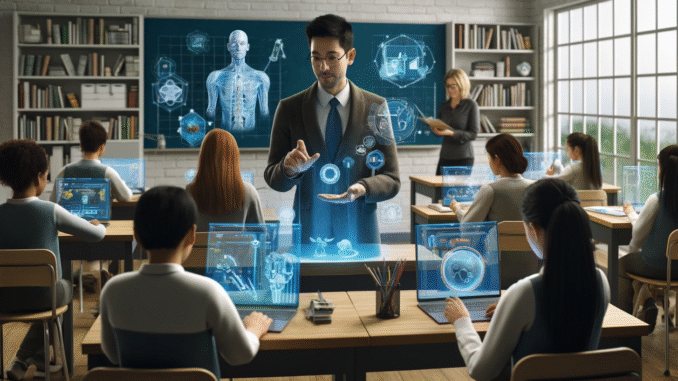
How Technology Is Transforming Education in 2025
The year 2025 has ushered in a new era of education, marked by rapid technological advancements that are reshaping how we teach and learn. The traditional classroom, once limited to chalkboards and textbooks, is now a dynamic, digital environment where students engage through interactive platforms, artificial intelligence, and immersive virtual tools.
From personalized learning paths to AI-powered tutors, technology is no longer just a support tool—it’s a driving force in education. This article explores how technology is transforming education in 2025 and what it means for students, teachers, and the future of learning.
1. AI-Powered Personalized Learning
One of the most profound impacts of technology in 2025 is the rise of artificial intelligence (AI) in education. AI is being used to tailor learning experiences to each student’s individual needs, strengths, and pace. Intelligent algorithms analyze performance data and deliver personalized lesson plans, quizzes, and feedback in real time.
Benefits of AI in education:
- Customized content delivery
- Early identification of learning difficulties
- Real-time progress tracking
- Reduced workload for teachers through automated grading
AI-driven platforms such as adaptive learning apps and smart tutoring systems are helping bridge achievement gaps and promote equity in education.
2. Virtual and Augmented Reality (VR/AR) Learning
In 2025, virtual reality (VR) and augmented reality (AR) are becoming standard tools in classrooms. These immersive technologies create engaging, 3D learning experiences that make complex concepts easier to grasp.
Examples include:
- Virtual science labs where students can conduct experiments safely
- AR-enabled textbooks that bring diagrams to life
- History lessons set in fully immersive historical simulations
Why it matters:
VR and AR increase retention rates and engagement, especially for visual and kinesthetic learners.
3. Hybrid and Remote Learning Are Here to Stay
The global shift to remote learning during the pandemic years paved the way for hybrid education models. In 2025, most institutions offer flexible learning options that combine online and in-person instruction.
Advantages of hybrid learning:
- Greater flexibility for students and teachers
- Accessibility for students in rural or underserved areas
- Recorded lectures for review and self-paced learning
With robust platforms like Microsoft Teams, Google Classroom, and newer AI-integrated systems, students can access quality education anytime, anywhere.
4. Blockchain for Education Credentials
Blockchain technology is revolutionizing how academic records are stored and shared. In 2025, digital diplomas and certificates are commonly issued on blockchain networks, ensuring authenticity and security.
Uses of blockchain in education:
- Tamper-proof credentials
- Transparent record-keeping
- Decentralized learning portfolios for students
Impact:
This technology simplifies verification processes for employers and universities, reducing fraud and speeding up applications.
5. Smart Classrooms and IoT Integration
Classrooms in 2025 are more than just digital—they’re intelligent. Internet of Things (IoT) devices such as smart boards, connected projectors, and real-time attendance systems are enhancing interactivity and classroom management.
Key features of smart classrooms:
- Sensor-based lighting and climate control for better learning environments
- Smart seating and assistive devices for special education
- Automated alerts for student engagement and participation levels
Result:
Teachers gain valuable insights into student behavior, helping them adapt teaching strategies on the fly.
6. Gamification of Learning
Gamification—the use of game elements in learning—is thriving in 2025. Education platforms use badges, leaderboards, point systems, and story-driven quests to increase motivation and engagement.
Why gamification works:
- Encourages healthy competition
- Makes learning fun and interactive
- Reinforces knowledge through repetition and rewards
Popular platforms like Kahoot!, Classcraft, and Duolingo have set the standard, while new AI-driven games are emerging to support complex subjects like coding, algebra, and language learning.
7. AI-Powered Language and Literacy Tools
Language learning in 2025 is faster and more accessible thanks to tools powered by natural language processing (NLP). These AI-driven apps help students with grammar correction, pronunciation, and real-time translation.
Examples:
- AI writing assistants for essays and reports
- Real-time voice translation tools in multilingual classrooms
- Chatbots for reading comprehension practice
Benefit:
These tools are especially helpful for ESL (English as a Second Language) students, enabling them to learn more independently and confidently.
8. Data-Driven Decision Making in Schools
Schools and districts are leveraging big data analytics to make informed decisions. Learning management systems now provide dashboards that track academic performance, behavior patterns, and attendance trends.
How it helps:
- Early intervention for at-risk students
- Curriculum adjustments based on real-time feedback
- Better resource allocation based on needs analysis
Outcome:
Educators and administrators can act faster and more effectively, improving outcomes at both individual and institutional levels.
9. EdTech for Special Needs Education
Technology in 2025 is empowering inclusive education like never before. Assistive technologies—such as speech-to-text software, screen readers, and adaptive hardware—support students with disabilities.
Innovations include:
- Eye-tracking software for non-verbal students
- AI tutors that adapt to neurodivergent learning styles
- Digital tools that allow personalized pacing and instructions
Result:
Students with special needs experience fewer barriers and more opportunities to succeed.
10. Teacher Training and Professional Development via Technology
Lastly, teachers themselves are benefiting from tech advancements. Online professional development courses, AI coaching tools, and virtual teacher communities help educators stay updated on best practices.
Training tools in 2025 include:
- Virtual simulations for classroom management
- On-demand webinars and microlearning modules
- Peer collaboration platforms
Why it matters:
When teachers grow, students benefit. Technology ensures that educators are continuously evolving with the changing landscape.
Final Thoughts
The transformation of education through technology in 2025 is not just about gadgets and software—it’s about creating equitable, engaging, and effective learning environments. Technology is breaking down barriers, personalizing education, and preparing students for a world where digital literacy is essential.
As with any transformation, challenges like data privacy, screen time, and digital equity remain. However, the ongoing integration of thoughtful, student-centered technology is undeniably shaping a brighter future for global education.
Educators, students, and policymakers must continue to collaborate and innovate to ensure technology serves its ultimate purpose: empowering every learner to reach their full potential.
